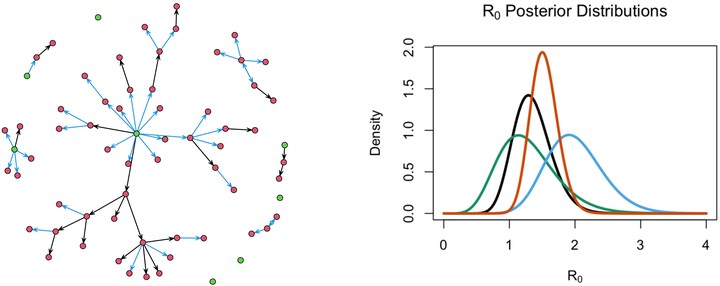Estimating Asymptomatic and Symptomatic Transmission of the COVID-19 First Few Cases in Selenge Province, Mongolia

Abstract
In this paper we undertake a scientific study of a COVID-19 outbreak in Sukhbaatar, Mongolia. We do so by analyzing data collected via contact tracing of cases by the rapid response team. We use a novel statistical model of the transmission networks to estimate outbreak characteristics and outbreak potential, including basic reproductive numbers for asymptomatic, pre-symptomatic and symptomatic cases.
Background: Following the first locally transmitted case in Sukhbaatar soum, Selenge province, we aimed to investigate the ultimate scale of the epidemic in the scenario of uninterrupted transmission.
Methods: This was a prospective case study following the locally modified WHO FFX cases generic protocol. A rapid response team collected data from November 14–29, 2020. We created a stochastic process to draw many transmission chains from this greater distribution to better understand and make inferences regarding the outbreak under investigation.
Results: The majority of the cases involved household transmissions (35, 52.2%), work transmissions (20, 29.9%), index (5, 7.5%), same apartment transmissions (2, 3.0%), school transmissions (2, 3.0%), and random contacts between individuals transmissions (1, 1.5%). The posterior means of the basic reproduction number of both the asymptomatic cases, R0Asy and pre-symptomatic cases R0Pre(1·35 [95% CrI 0·88−1·86] and 1·29 [95% CrI 0·67−2·10], respectively), were lower than that of the symptomatic cases (2.00 [ 95% Crl 1.38-2.76]).
Conclusion: Our study highlights the heterogeneity of COVID-19 transmission across different symptom statuses and underscores the importance of early identification and isolation of symptomatic cases in disease control. Our approach, which combines detailed contact tracing data with advanced statistical methods, can be applied to other infectious diseases, facilitating a more nuanced understanding of disease transmission dynamics.
This work is dedicated to Andrew Shapiro.
Andrew’s intelligence, insight, skill and perseverance are all expressed in this article.